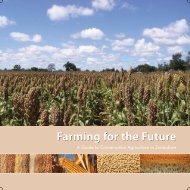Restoring the Soil - Canadian Foodgrains Bank
Restoring the Soil - Canadian Foodgrains Bank
Restoring the Soil - Canadian Foodgrains Bank
Create successful ePaper yourself
Turn your PDF publications into a flip-book with our unique Google optimized e-Paper software.
56Decision Tree GuideHowever, if fruit trees are used for shade, something must be done to providesoil fertility. Farmers who want to improve <strong>the</strong>ir coffee fields’ fertility can useperennial peanuts (Arachis pintoi) as a low-lying gm/cc, if <strong>the</strong>y can get <strong>the</strong>cuttings. Perennial peanuts are a little difficult to get established, but once <strong>the</strong>yare established, <strong>the</strong>y provide a cover less than 20 cm thick that will completelycontrol weeds and fix nitrogen for as long as it is in <strong>the</strong> ground. Choose S28 andgo to #5.If farmers cannot obtain perennial peanut cuttings, <strong>the</strong>y will usually settle forjackbeans as an intercrop with <strong>the</strong>ir coffee. See S29, <strong>the</strong>n go to #5. Also see <strong>the</strong>description of jackbeans in #29.58. Coconuts, oil palms or cacao. Select S26 (or S29 if perennial peanut cuttings arenot available) and go to #5.59. Gm/ccs for fruit trees. I have seen jackbeans, mucuna, perennial peanuts andCentrosema pubescens used as gm/ccs for fruit trees. I believe <strong>the</strong> perennial peanutis easily <strong>the</strong> best of <strong>the</strong>se systems. See S26 <strong>the</strong>n go to #5. Centrosema works wellas a perennial, but forms a mat of about 30-40 cm in depth; this means fruit thatdrops is often lost. As well, <strong>the</strong> Centrosema might become a cover for snakes. Ifextension workers and <strong>the</strong> farmers favor this system, go to S67 and <strong>the</strong>n to #5.Jackbeans can be used, but have to be replanted every year or two. Go to S38,and <strong>the</strong>n #5. Mucuna would have to be replanted every year in most climates,and would also have to be trimmed regularly around <strong>the</strong> trees. I consider mucunaas advantageous only where farmers have a serious problem with sun scorch (as<strong>the</strong>y do in Paraguay, where farmers are very happy with mucuna). In this case,use S37 and <strong>the</strong>n go to #5.60. Much of <strong>the</strong> land is wasteland. See S77, which can be used with <strong>the</strong> normalannual mucuna, or <strong>the</strong> perennial species. In most situations, however, it wouldbe better to plow <strong>the</strong> soil and broadcast jackbean seeds on it, at a rate of approximately4 seeds/m 2 . If <strong>the</strong> soil is so infertile that even jackbeans will not grow on it(an extremely rare phenomenon), you might use a little animal manure to get <strong>the</strong>jackbean started.
















